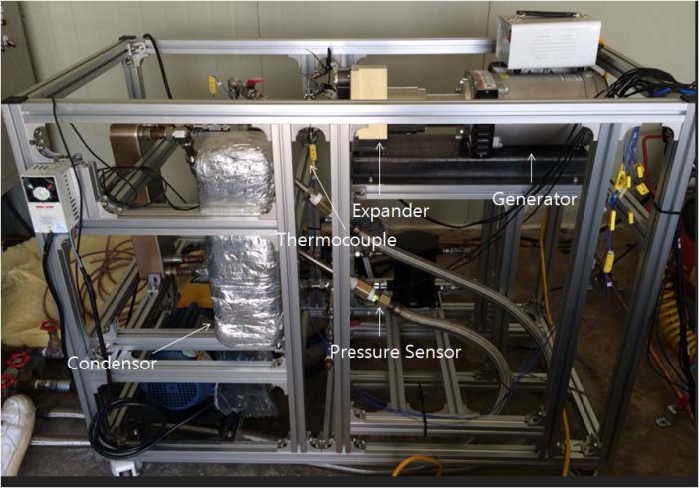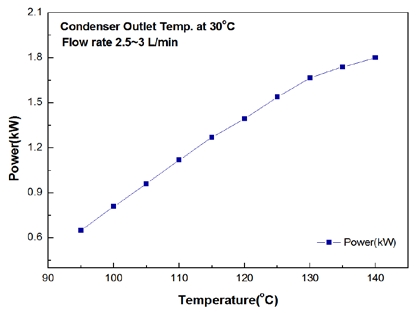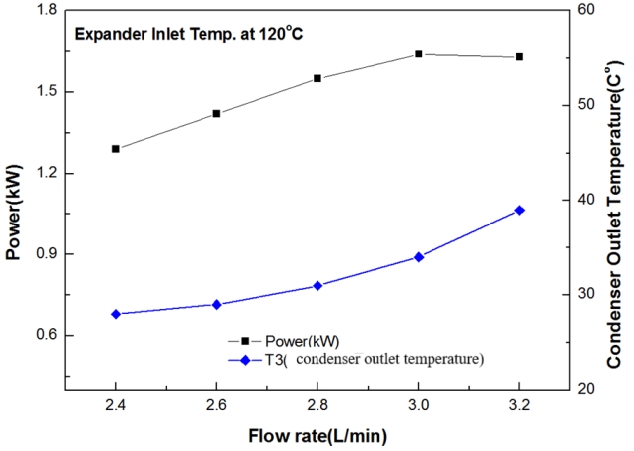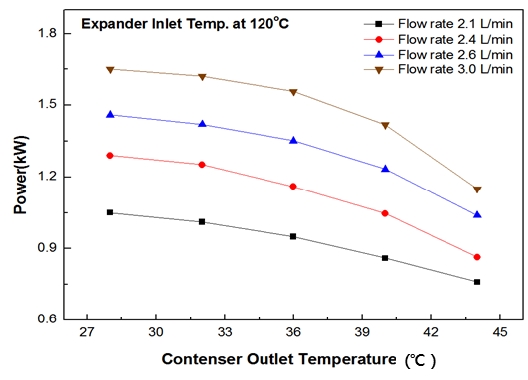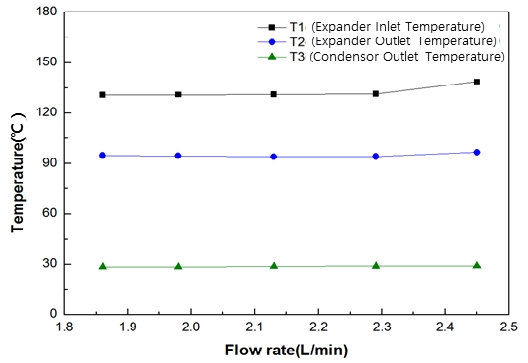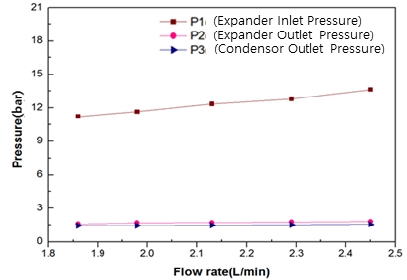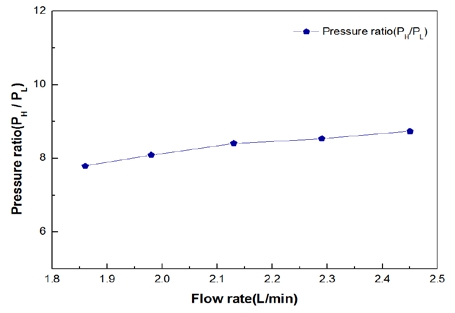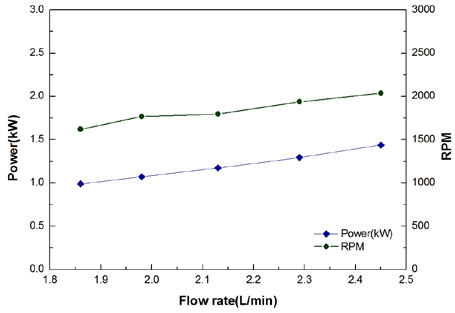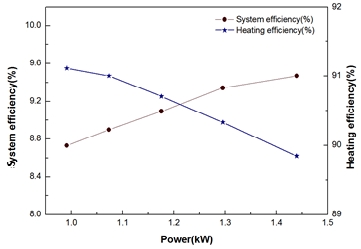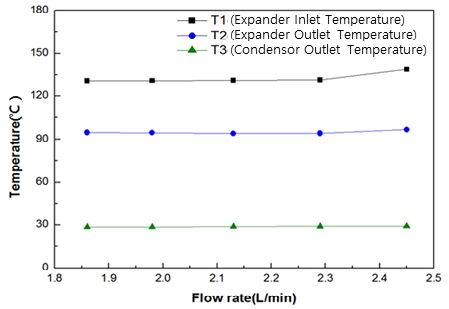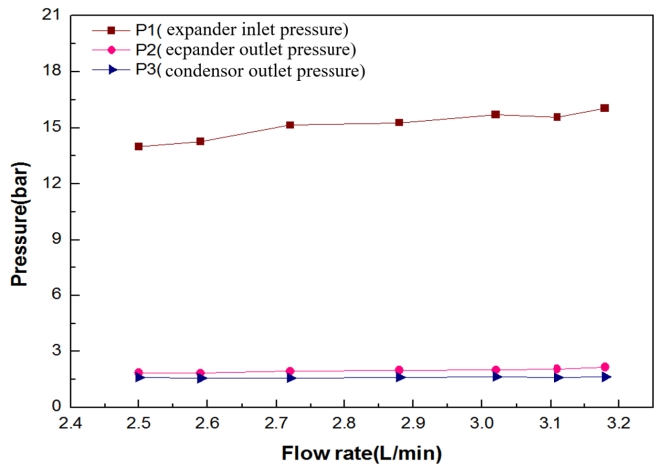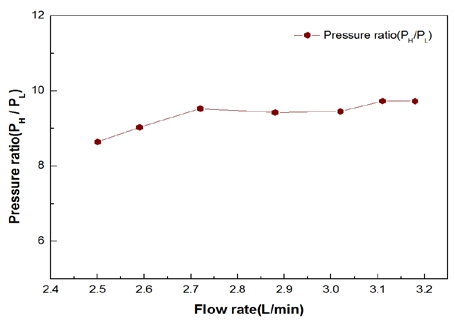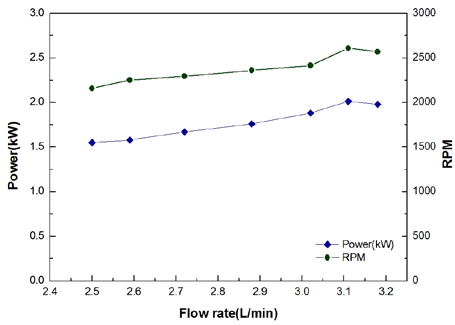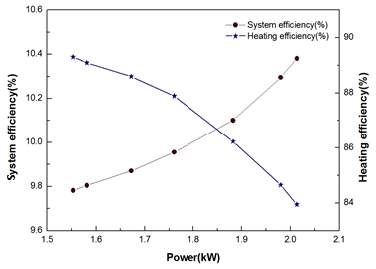
Experimental study on organic Rankine cycle for application to 1 kW solar power generation system
Copyright ⓒ The Korean Society of Marine Engineering
This is an Open Access article distributed under the terms of the Creative Commons Attribution Non-Commercial License (http://creativecommons.org/licenses/by-nc/3.0), which permits unrestricted non-commercial use, distribution, and reproduction in any medium, provided the original work is properly cited.
Abstract
To reduce greenhouse gas emissions, renewable energy that does not require the use of fossil fuels is attracting increasing attention. In this study, a performance tester was designed and manufactured to develop an organic Rankine cycle power generation system for application to a small, 1 kW solar power generation system using solar heat as renewable energy, and a performance test was conducted. The performance of the organic Rankine cycle power generation system and a scroll expander, a key component of the system, was evaluated. Based on the results, the organic Rankine cycle power generation system could be improved. To test the application of this system to solar boilers, solar boilers for home use were installed. A prototype of the organic Rankine cycle power generation system was combined with a solar boiler to test its performance. This paper reports on the designed and manufactured performance test equipment. Performance test results, such as power, rated power, maximum power, system efficiency, and heating efficiency of the organic Rankine cycle power generation system are presented.
Keywords:
Greenhouse gases (GHGs), Renewable energy, Solar power generation system, Organic Rankine cycle (ORC), Scroll expander1. Introduction
Renewable energy has attracted much attention because it is eco-friendly and can produce energy without using fossil fuels [1]. Numerous studies in this regard have been conducted in both the marine and land sectors. For example, studies on offshore wind power generation have been performed, which has enabled the construction of large-scale wind farms and secured excellent wind resources [2]. Studies on ocean thermal energy conversion systems, which generate power using temperature differences between surface and deep water, have also been conducted [3].
In terms of power generation systems that use various renewable energy sources, this study aimed to contribute knowledge on solar power generation. The authors have published several experimental studies on organic Rankine cycles (ORCs). For instance, Ryu et al. [4] constructed an experimental setup to apply a high-efficiency single-loop ORC engine waste heat recovery system—which could simultaneously use high-temperature exhaust heat and low temperature cooling water heat generated by a diesel engine—to actual diesel engines and illustrated the applicability of the system. Shin et al. [5] introduced the performance of a radial turbine applied as the expander of a 10 kW ORC system to waste heat recovery from internal combustion engines.
In the present study, a system for both heating and power generation was developed by applying an ORC to a solar power generation system that could be applied to small vessels. The results showed that the developed system had various benefits, such as fuel diversity, low noise, low vibration, size reduction, and weight reduction.
Kim et al. [6] published a theoretical study on the optimal design of a power generation system to develop a cogeneration system that could generate electric power and use condensation heat for heating by applying an ORC power generation system to a solar collector for home use. Based on the theoretical results of Kim et al. [6], an experimental study on an ORC power generation system applied to a small 1 kW solar power generation system was conducted, and the results are presented in this paper.
2. Experimental Setup and Method
To develop an ORC power generation system that could supply a rated power of 1 kW with 80% heating efficiency using a solar boiler, performance test equipment was designed and fabricated. An ORC power generation system and a scroll expander, a key component of the system, were fabricated, and their performances were tested. Based on the results, the performance of the ORC power generation system was improved. To test the application of the system to solar boilers, a solar boiler for home use was installed. A prototype of the ORC power generation system was combined with the solar boiler, and its performance was tested.
When solar heat is directly used to evaluate the performance of an ORC power generation system, stable temperature control is difficult, and it is difficult to conduct tests, depending on the weather. Thus, a thermal oil heating system was used in the experiment. The system allowed precise temperature control up to 300 ℃, because heat was indirectly transferred to the evaporator of the ORC power generation system. The capacity of the heater was 43,000 kcal/h. The cooling capacity of the condensation water cooling system was 28,000 kcal/h, and the condensation water temperature could be stably maintained and precisely controlled, as an air-cooling system was used.
The ORC power generation system consisted of an evaporator to transfer the high-temperature heat of the thermal oil to the working fluid of the system, an expander to convert the expansion force of the working fluid into shaft power, a condenser at the end of the expander to cool the working fluid and convert it to liquid, a circulation pump to circulate the working fluid, a liquid receiver, a flowmeter, a pressure sensor, and a temperature sensor. A plate heat exchanger, with a maximum working pressure of 30 bar and a heat transfer area of 1,595 m2, was used. The liquid receiver was designed and fabricated to store extra working fluid inside the system, and its capacity was 3 RT. As for the expander, a scroll expander was used, and it converted the thermal energy of the high-temperature and pressure working fluid into kinetic energy. A 1,750 rpm diaphragm pump was used as the refrigerant circulation pump. Its maximum discharge flow rate was 4.5 L/min, and R245fa refrigerant was used. Compared to R134a, a high-pressure refrigerant, R245fa can improve efficiency because of its increased evaporation temperature under operating conditions, and it can lower the system operating pressure. Table 1 shows the specifications of the expander used in this study, and Figure 1 shows the experimental setup.
3. Experimental Results and Discussion
3.1. ORC power generation system performance analysis
The power of the ORC power generation system was closely related to the solar collector temperature, condensation temperature, and refrigerant flow rate. The performance of this system involved the power according to the solar collector and condensation temperatures at each flow rate. A generator capable of producing 1 kW at 2,500 rpm was installed and tested. The power was mainly determined by the expander inlet and condenser outlet pressures. The expander inlet pressure varied depending on flow temperature and refrigerant flow rate. Therefore, the power according to flow temperature was examined under the same condensation temperature and refrigerant flow rate conditions.
Figure 2 shows the power according to solar collector temperature at a condensation temperature of 30 ℃ and refrigerant flow rates of 2.5–3.0 L/min. The ORC power generation system operated at solar collector temperatures of up to 80 ℃, but its power was lower than 400 W. The rpm of the expander was also very low, making it difficult to obtain sufficient power. Therefore, solar collector temperature needed to be higher than approximately 90 ℃ for the operation of the system. When flow temperature increased from 95 to 140 ℃ at a condensation temperature of 30 ℃, the power increased from 0.65 to 1.8 kW. The efficiency of the ORC power generation system could be improved by increasing solar collector temperature. As the efficiency improvement required higher temperature and pressure for the ORC power generation system, solar collector temperature was increased from 95 to 140 ℃ for stable operation.
Figure 3 shows the power and condensation temperature according to flow rate at a solar collector temperature of 120 ℃. A maximum power of 1.64 kW was observed when the refrigerant flow rate was 3.0 L/min. In this instance, the condensation temperature was approximately 34 ℃. When the refrigerant flow rate was 3.2 L/min, the power was 1.63 kW, but the condensation temperature was approximately 40 ℃. At a refrigerant flow rate of 3.0 L/min, the power did not increase even if the flow rate increased. This appeared to have been because condensation temperatures exceeding 40 ℃ no longer contributed to power increase. Therefore, a refrigerant flow rate of 3.0 L/min could lead to maximum power at a solar collector temperature of 120 ℃.
Figure 4 shows the power according to condensation temperature for each flow rate at a solar collector temperature of 120 ℃. The power according to condensation temperature was compared while the flow rate varied at the same solar collector temperature. The power decreased with increasing condensation temperature and increased with increasing refrigerant flow rate. When the condensation temperature was 30 ℃, the power was approximately 1.0 kW at a refrigerant flow rate of 2.1 L/min and approximately 1.6 kW at 3.0 L/min. The power decreased to 0.86 and 1.4 kW, respectively, when the condensation temperature was increased to 40 ℃.
3.2. Rated power test
The rated power of an ORC power generation system with a solar boiler is the power generated when the system operates and generates power stably. The rated power test was conducted under the same flow and condensation temperature conditions. Figure 5 shows the temperature according to the refrigerant flow rate. The expander inlet temperature was maintained at 130 ℃, as with flow temperature, and the condenser outlet temperature was maintained at approximately 30 ℃. When these temperatures were constantly maintained, the power according to the flow rate was measured. The refrigerant flow rate was increased by approximately 0.13 L/min from 1.86 to 2.45 L/min.
Figures 6 and 7 show the pressure and pressure ratio (expansion ratio), respectively, according to refrigerant flow rate. While the condenser outlet pressure was constantly maintained, the expander inlet pressure slowly increased from approximately 11.2 to 13.6 bar. This appeared to have been because the amount of heat from the evaporator increased as the refrigerant flow rate gradually increased. The condenser outlet pressure was constantly maintained at 1.5 bar. Consequently, the expansion ratio increased from 7.8 to 8.7, with an average of 8.3.
Figure 8 shows the expander rpm and power according to the refrigerant flow rate. As the refrigerant flow rate increased, the expander rpm increased from 1,600 to 2,000 rpm, and the produced power increased from 1.0 to 1.44 kW. These values exceeded the target rated power of 1 kW, indicating that power of approximately 1.15 kW could be continuously generated at approximately 2.0 L/min.
Figure 9 shows the system (power generation) efficiency and heating efficiency according to power. As solar heat input was used for both the power generation of the ORC power generation system and the heat of the condenser for heating in the solar cogeneration system, the system and heating efficiencies were defined as follows:
- ‣ System efficiency [%] = Generated power [kW] / heat input[kW] * 100
- ‣ Heat input = refrigerant mass flow rate [kg/s] * (evaporatoroutlet enthalpy – evaporator inlet enthalpy) [kJ/kg.K]
- ‣ Heating efficiency [%] = Heat discharged from condenser[kW] / heat input [kW] * 100
- ‣ Heat discharged from condenser = refrigerant mass flow rate[kg/s] * (condenser inlet enthalpy – condenser outletenthalpy) [kJ/kg.K]
The system efficiency increased in proportion to the refrigerant evaporation temperature (pressure) and expander efficiency. The heating efficiency decreased as the efficiency of the ORC power generation system increased. This was because the amount of heat from the solar collector was limited. Thus, if the ORC power generation system generated more power by consuming heat, the heat supplied to the heating water relatively decreased, reducing the heating efficiency.
In the case of volumetric expanders, such as scroll expanders, over-expansion occurs if the design operation expansion ratio is higher than the actual operation expansion ratio, and under-expansion occurs if it is lower than the actual operation expansion ratio. The design expansion ratio of the expander used in this study was 4. As it was lower than the operation expansion ratios of 8–9, moderate efficiency reduction occurred during under-expansion [7]. In general, the expander size increases in proportion to the increase in design expansion ratio, and the expander efficiency sharply decreases if over-expansion occurs under off-design conditions. Therefore, the design expansion ratio is usually low to maintain under-expansion [7].
3.3. Maximum power test
In the maximum power test, the temperature of the low temperature part of the ORC power generation system had to be as low as possible for the solar boiler to produce maximum power. Owing to the nature of the system, however, the operation of the ORC power generation system supplied heat to the water in the heat storage tank, which was used as condensate, resulting in reduced power. Therefore, the test was conducted when the heat storage tank water temperature was as low as possible and unchanged. In addition, the flow rate was changed based on a solar collector temperature of 140 ℃, which was the target of this study, and the condensation temperature was maintained at 30 ℃.
Figure 10 shows the temperature according to flow rate. The expander inlet temperature was maintained at 140 ℃, as with the solar collector temperature, and the condenser outlet temperature was maintained at approximately 30 ℃. When these temperatures were constantly maintained, the power according to the flow rate was measured. The refrigerant flow rate increased by approximately 0.1–0.13 L/min from 2.5 to 3.2 L/min.
Figures 11 and 12 show the pressure and pressure ratio (expansion ratio), respectively, according to the flow rate. The expander inlet pressure slowly increased from approximately 14 to 16 bar as the flow rate increased. The condenser outlet pressure was constantly maintained at approximately 1.6 bar. Consequently, the expansion ratio increased from 8.6 to 9.7, with an average of 9.3.
Figure 13 shows the expander rpm and power according to flow rate. As the flow rate increased, the expander rpm increased from 2,200 to 2,600 rpm, and the power increased from 1.55 to 2.0 kW. The maximum power was 2.7 kW when the refrigerant flow rate was 3.1 L/min.
Figure 14 shows the system and heating efficiencies according to the refrigerant flow rate. The maximum system efficiency was 10.4%, and the corresponding heating efficiency was 84%. The system efficiency was calculated as the ratio of the power generated by the expander to the heat input to the ORC power generation system. The system efficiency was defined as the general ORC cycle efficiency and was calculated as the ratio of pure power (the power obtained by subtracting the refrigerant pump input from the expander output) to heat input to the refrigerant.
Since the solar collector and heat regenerator circulation pumps had to be operated for heating by solar heat and for ORC power generation, it was reasonable not to include them in the cycle efficiency. The refrigerant pump input should be measured for strict system efficiency calculation, but it was not measured in this performance evaluation. The pump power calculated from the refrigerant enthalpy difference between the pump inlet and outlet was approximately 3% of the power generated by the expander; it was approximately 5% even if the pump efficiency was considered. Therefore, considering the pump power, a maximum efficiency of 9.9%, which was approximately 5% lower than the maximum system efficiency of 10.4% calculated from the performance test results, was achieved. The maximum system efficiency was achieved under the maximum 2.0 kWe condition. This was because the refrigerant evaporation temperature increased, and the system efficiency improved as the expander inlet pressure increased.
In this study, a 1.0 kWe expander, the smallest capacity on the market, was applied to the developed ORC power generation system. If the expander inlet pressure was increased to improve the system efficiency, as the inlet pressure presented in the design specifications was low, the power could be increased to 2.0 kWe. Therefore, for the current system (which achieved a 10% system efficiency at a maximum power of 2.0 kWe) to achieve a 10% system efficiency at a rated power of 1.0 kWe, the size of the expander that maintained the inlet pressure at approximately 16 bar under the current 2.0 kWe condition could be halved based on the volume flow rate, so that the expander could maintain an inlet pressure of approximately 16 bar at 1.0 kWe.
In the final performance evaluation, the heat input to the evaporator and heat from the condenser for heating were calculated using the refrigerant enthalpy difference. Furthermore, heat loss from the heat exchangers and pipes was not considered, because insulating materials were used to minimize heat loss. The overall efficiency, which is the sum of cycle and heating efficiencies, was 94% or higher, indicating that heat loss was minimized.
Expander efficiency had the largest impact on the cycle efficiency of the ORC power generation system. The isentropic expansion efficiency, which was calculated as the ratio of the expander output to the theoretical maximum work by the isentropic process, ranged from 70 to 80%, which is the highest level of expansion efficiency for a 1 kWe expander. Heat exchanger performance had the second-largest impact on the cycle efficiency of the ORC power generation system. The efficiency of the heat exchangers used in evaporators and condensers with phase changes was not evaluated by their effectiveness but was expressed by the pinch temperature, which is the minimum temperature difference in a heat exchanger.
Since the pinch temperature decreased under the given heat source and cooling water, the cycle efficiency increased because the evaporation temperature increased, and the condensation temperature decreased. To decrease the pinch temperature, however, the size of the heat exchanger needed to be increased. Therefore, the pinch temperature was optimized from this trade-off relationship. The final performance evaluation results showed that the pinch temperature of the evaporator, calculated from the temperatures of the heat medium (water) and refrigerant at the inlet and outlet, was less than 2 ℃, and that of the condenser, calculated from the temperatures of the cooling water and refrigerant at the inlet and outlet, was less than 3 ℃. As the pinch temperatures were low, the improvement of the heat exchanger performance was not expected to contribute significantly to system efficiency improvement and was likely to be negative in economic point of view.
4. Conclusion
In this study, performance test equipment was designed and fabricated to develop an ORC power generation system for application to a small 1 kW solar power generation system, and performance tests were conducted. The results of this study can be summarized as follows:
- 1) Based on a solar collector temperature of 120 ℃, the developed ORC power generation system produced approximately 1.0 kW at a refrigerant flow rate of 2.1 L/min and 1.6 kW at 3.0 L/min at a condensation temperature of 30 ℃; at a condensation temperature of 40 ℃, it produced 0.86 and 1.4 kW, respectively. In other words, power increased as the condensation temperature decreased and flow rate increased.
- 2) The rated power was approximately 1.15 kW at a refrigerantflow rate of approximately 2.0 L/min. In the rated power test,the system and heating efficiencies ranged from 8.8 to 9.7% and 89.2 to 91.2%, respectively.
- 3) The maximum power was 2.7 kW at a refrigerant flow rate of 3.1 L/min. In the maximum power test, the maximum system efficiency was 10.4%, and the corresponding heating efficiency was 84%.
Author Contributions
Conceptualization, Y. H. Ryu; Methodology, Y. M. Kim; Investigation, D. G. Shin; Writing-Original Draft Preparation, Y. H. Ryu; Visualization, D. G. Shin; Writing-Review & Editing, D. G. Shin and Y. M. Kim; Resources, D. G. Shin and Y. M. Kim; Supervision, Y. H. Ryu; Validation, All Authors.
References
- Korea Energy Agency New & Renewable Energy Center, https://www.knrec.or.kr/main/main.aspx, , Accessed April 22, 2020.
-
J. H. Lee, K. H. Jung, and J. C. Park, and S. J. Kim, "Determination of optimum protection potential for cathodic protection of offshore wind-turbine-tower steel substructure by using potentiostatic method," Journal of the Korean Society of Marine Engineering, vol. 41, no. 3, pp. 230-237, 2017 (in Korean).
[https://doi.org/10.5916/jkosme.2017.41.3.230]

-
J. O. Mo, S. W. Cha, Y. T. Kim, T. W. Lim, and Y. H. Lee, "CFD performance analysis and design of a 8kW class radial inflow turbine for ocean thermal energy conversion using a working fluid of ammonia,", Journal of the Korean Society of Marine Engineering, vol. 36, no. 8, pp. 1030-1035, 2012 (in Korean).
[https://doi.org/10.5916/jkosme.2012.36.8.1030]

-
Y. H. Ryu, Y. M. Kim, and D. G. Shin, "Preliminary study of an engine waste heat recovery system for diesel engine applications," Journal of the Korean Society of Marine Engineering, vol. 42, no. 3, pp. 161-165, 2018 (in Korean).
[https://doi.org/10.5916/jkosme.2018.42.3.161]

-
D. G. Shin, Y. M. Kim, and Y. H. Ryu, "Experimental study on performance of radial turbine with 10 kW-ORC applied to internal combustion engine," Journal of the Korean Society of Marine Engineering, vol. 42, no. 4, pp. 246-251, 2018 (in Korean).
[https://doi.org/10.5916/jkosme.2018.42.4.246]

- Y. M. Kim, D. G. Shin, C. G. Kim, and S. T. Lee, “Design and optimization of domestic Organic Rankine Cycle (ORC) co-generation system with solar collectors,” Journal of Energy Engineering, vol. 22, no. 4, pp. 463~468, 2013 (in Korean).
-
Y. M. Kim, D. G. Shin, and C. G. Kim, “Optimization of design pressure ratio of positive displacement expander for vehicle engine waste heat recovery,” Energies, vol. 7, no. 9, pp. 6105-6117, 2014.
[https://doi.org/10.3390/en7096105]



